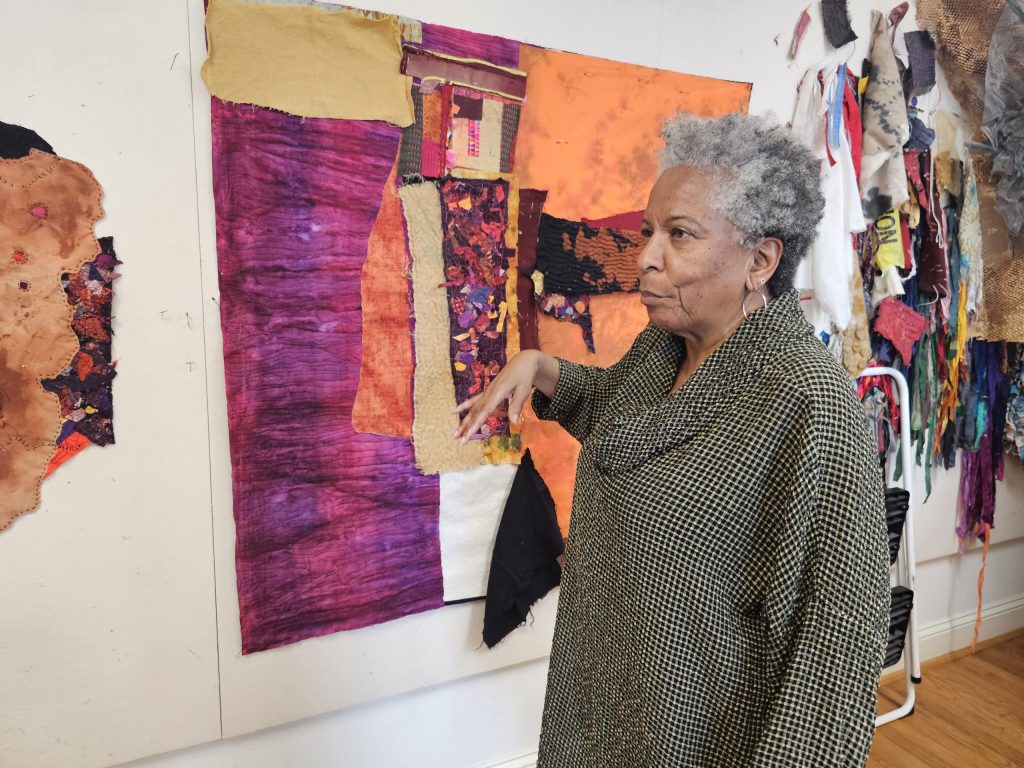DETROIT – Art historians often credit white men as pioneers of modern abstraction, from Piet Mondrian to Jackson Pollock. But there is an alternative lineage of non-figurative composition built by women, people of color, and fiber artists: quilt making. As archives like the Quilt Index prove, for every straightforward, functional quilt, there are a dozen that boldly experiment with abstract form, color, motifs. and material, sometimes because of need and poor material, but sometimes because of joy, self-expression and artistic experimentation.
Detroit fiber artist Carole Harris, now 81, can’t remember exactly when she learned to sew.
“It’s always been there. I grew up in Detroit and learned through the public school system, in elementary school,” Harris said in an interview in her cozy studio next to the apartment she shares with her husband in Detroit’s historic Park Shelton building. “I always start my art talks with the first quilt I make, this (She and writer Bill Harris are coming up on their 60th anniversary.) “Basically, it was just a pinwheel pattern,” she added, “but I was making clothes before that, too.”

Like many trained seamstresses, Harris first applied her talents to functional objects, including clothing and quilts, before eventually using her interest in form, fabric and color in a career in design. During this time, however, he always maintained an interest in fiber art as a form of expression that could be freer. transitory, and much less simple to define.
These compositions are narrative without being literal, resembling detailed maps in their layered texture. Harris’s constructions are evocative yet understated, allowing the viewer to wander through the visual field guided by paths of elaborate machine-stitched elements and expressive hand-stitched elements.

The group of works and the individual titles refer to some of Harris’s timeless themes: memory, time and jazz. Rhythm, Repetition and Vocabulary, a 2018 exhibition at the Detroit Institute of Arts, compared his work to that of painter Allie McGhee, whose signature visual aesthetic drew a line of connection between the artists who remember jazz. Just as the frenetic nature of jazz music belies years of training that allow musicians to improvise and intuit harmonious outcomes from chaotic beginnings, the effect of Harris’s fiber works is a work rhythm paradoxically based on a meticulous attention to form.
“Craft is still important to me, even though what I do now is imperfection and embracing imperfection,” Harris said. “But you have to work to make it so.”
This reverence for the work process is one of many that Harris says a Detroiter at heart. In a town built on industrialized craftsmanship, hard work is valued, whether it’s done in a factory or an artist’s studio.

“I’m just trying to work hard now,” Harris said. “And the more I try, the smaller I become; I really get into the details and the work.’
Regardless of his intentions, new pieces rarely start out big. They are it’s likely to grow into a minute study constructed from tiny enough to fit in the artist’s hands, like a log cabin quilting block. This ability to create inspiration from the smallest components is a double-edged sword: it leaves Harris’ studio overflowing with a collection of fibers, because there is no small scrap to throw away. His scrap yarn is also deposited and pressed onto a water-soluble medium, and fused into vibrating patches of moss, to be passed on to future works.

“I’ve started making balls with my yarn scraps,” Harris admitted, retrieving a bag of colorful fairy-sized balls of yarn. “I stockpile them here until I get enough, or have time to make marbles, or whatever. Talk about collecting, I can’t throw anything away.’
Harris makes a good case for the practice of retention: The wealth of detail reflects his commitment to memory, including its gaps. In places, his compositions are crisp and neat, like a well-rehearsed story that is fully realized in the mind’s eye. But like memory, these places are full of meandering threads, burnt holes, rusted spots, and bright flashes that call for attention.
Although Harris has experimented with cooler palettes, his signature works tend to lean heavily toward magenta, orange, and gold.
“I think magenta goes back to my time in college,” said Harris, who graduated from Wayne State University. “I had this art teacher who was a wonderful woman. Her life was full of art, and if you ever went to her house, it was just magical. Her hair was pulled back in a bun, and she always wrapped it in magenta and purple strands. And I think I’ve loved those colors ever since.”

Harris’s work and the beautiful Wunderkammer-like environments of her studio and home—a monument to memory, transience, collecting (not collecting!) and aesthetics itself—invite us to delve into the details and follow us to a place of imagination. His creations have a beautiful kind of economy where even old rusty machine parts can be turned into a gilded patina in one of his sensuous memory maps. In work and in life, Harris wants to hold on to everything.
“Nothing goes to waste,” she said, rolling a marble of her threads between her fingers. “It’s all part of the growth process.”




